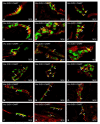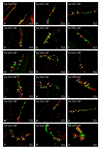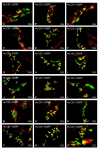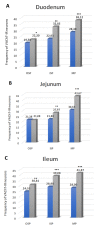Effect of Streptozotocin-Inducted Diabetes on the Pathophysiology of Enteric Neurons in the Small Intestine Based on the Porcine Diabetes Model
- PMID: 32192078
- PMCID: PMC7139978
- DOI: 10.3390/ijms21062047
Effect of Streptozotocin-Inducted Diabetes on the Pathophysiology of Enteric Neurons in the Small Intestine Based on the Porcine Diabetes Model
Abstract
Hyperglycemia is one of the main causes of diabetes complications. Gastrointestinal (GI) disturbances are one of the most frequent complications during diabetes. The porcine digestive tract possesses physiological and pathological similarities to the human digestive tract. This also applies to the innervation of the gastrointestinal tract. In this study, the influence of experimentally-inducted hyperglycemia was examined on the expression of vesicular acetylcholine transporter (VAChT), cocaine- and amphetamine-regulated transcript (CART), galanin (GAL), vasoactive intestinal polypeptide (VIP), and calcitonin gene-related peptide (CGRP) in the enteric nervous system (ENS) neurons in the small intestine of the pig. During the current study, an increased number of neurons containing CART, VIP, GAL, and CGRP under streptozotocin injection were observed. The augmentation of expression included all enteric plexuses present in the small intestine. The same results were obtained in the case of VAChT; namely, chronic hyperglycemia led to an increase in the number of neurons utilizing VAChT in all investigated plexuses. The obtained results suggested that the function of neuropeptides studied in this experiment depended on their localization in the ENS structures, as well as part of the GI tract. Diabetes led to alterations in the neurochemical phenotype of small intestine enteric neurons.
Keywords: diabetes; enteric nervous system; gastrointestinal complications; neuropeptides; pig.
Conflict of interest statement
The authors declare no conflict of interest.
Figures










Similar articles
-
Hyperglycaemia-Induced Downregulation in Expression of nNOS Intramural Neurons of the Small Intestine in the Pig.Int J Mol Sci. 2019 Apr 4;20(7):1681. doi: 10.3390/ijms20071681. Int J Mol Sci. 2019. PMID: 30987291 Free PMC article.
-
The Influence of Inflammation and Nerve Damage on the Neurochemical Characterization of Calcitonin Gene-Related Peptide-Like Immunoreactive (CGRP-LI) Neurons in the Enteric Nervous System of the Porcine Descending Colon.Int J Mol Sci. 2018 Feb 12;19(2):548. doi: 10.3390/ijms19020548. Int J Mol Sci. 2018. PMID: 29439512 Free PMC article.
-
Cocaine- and amphetamine-regulated transcript (CART) peptide in the enteric nervous system of the porcine esophagus.C R Biol. 2018 Jul-Aug;341(6):325-333. doi: 10.1016/j.crvi.2018.06.006. Epub 2018 Jul 5. C R Biol. 2018. PMID: 29983247
-
CART in the enteric nervous system.Peptides. 2006 Aug;27(8):2024-30. doi: 10.1016/j.peptides.2005.12.015. Epub 2006 Jun 8. Peptides. 2006. PMID: 16759747 Review.
-
The nature of catecholamine-containing neurons in the enteric nervous system in relationship with organogenesis, normal human anatomy and neurodegeneration.Arch Ital Biol. 2017 Sep 1;155(3):118-130. doi: 10.12871/00039829201733. Arch Ital Biol. 2017. PMID: 29220864 Review.
Cited by
-
Cocaine- and amphetamine-regulated transcript (CART) peptide-positive neuron populations in the enteric nervous system of the porcine descending colon depend on age and gender.PLoS One. 2025 Apr 4;20(4):e0321339. doi: 10.1371/journal.pone.0321339. eCollection 2025. PLoS One. 2025. PMID: 40184385 Free PMC article.
-
Differential Effects of Losartan and Finerenone on Diabetic Remodeling, Oxidative Stress and ACE Activity in the Gastrointestinal Tract of Streptozotocin-Induced Diabetic Rats.Int J Mol Sci. 2025 Jun 29;26(13):6294. doi: 10.3390/ijms26136294. Int J Mol Sci. 2025. PMID: 40650071 Free PMC article.
-
Glyphosate-induced changes in the expression of galanin and GALR1, GALR2 and GALR3 receptors in the porcine small intestine wall.Sci Rep. 2024 Apr 17;14(1):8905. doi: 10.1038/s41598-024-59581-8. Sci Rep. 2024. PMID: 38632282 Free PMC article.
-
Gut Region-Specific Interleukin 1β Induction in Different Myenteric Neuronal Subpopulations of Type 1 Diabetic Rats.Int J Mol Sci. 2023 Mar 18;24(6):5804. doi: 10.3390/ijms24065804. Int J Mol Sci. 2023. PMID: 36982878 Free PMC article.
-
Immunodetection of P2X2 Receptor in Enteric Nervous System Neurons of the Small Intestine of Pigs.Animals (Basel). 2022 Dec 17;12(24):3576. doi: 10.3390/ani12243576. Animals (Basel). 2022. PMID: 36552495 Free PMC article.
References
-
- Furness J.B., Callaghan B.P., Rivera L.R., Cho H.J. The enteric nervous system and gastrointestinal innervation: Integrated local and central control. Adv. Exp. Med. Biol. 2014;817:39–71. - PubMed
-
- Furness J.B. The enteric nervous system: Normal functions and enteric neuropathies. Neurogastroenterol. Motil. 2008;20(Suppl. 1):32–38. - PubMed
-
- Schemann M., Neunlist M. The human enteric nervous system. Neurogastroenterol. Motil. 2004;16(Suppl. 1):55–59. - PubMed
MeSH terms
Substances
LinkOut - more resources
Full Text Sources
Research Materials

